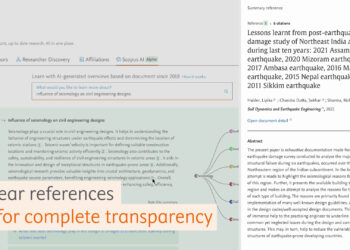
When Mendeley was founded, the apparent aim was to build a fully operational business. The Mendeley team worked from the tech industry playbook: develop an innovative service; wherever possible leverage the investments of others (e.g., published research material); move aggressively to build a large user base; finance the company through equity, in this case venture capital; and focus on revenue generation later. Cynics, who don’t understand equity financing, criticized the company for losing money, even though the same could have been said about such giants as Google and Facebook in their early days (but never about Microsoft), and look at them now. As time passed Mendeley attempted to create a revenue model. This was fatuous, as all of the ideas for monetization put Mendeley into commodity businesses (e.g., hosting content) where scale is everything, but it was an honest attempt. Meanwhile, IP lawyers were lurking in the background, trying to determine the best time to drop a lawsuit on the backs of the earnest management.
What we discovered in time was that Mendeley was not a business but a feature. Its acquisition by Elsevier proved the point: of little or no economic value on its own, when bolted onto Elsevier’s existing operations, Mendeley added new value to its users but especially to Elsevier itself, which was now in a position to get a wide view of the usage of a huge amount of research material, its own and the publications of others. Not incidentally, this was in part a library bypass strategy, as Mendeley provided Elsevier with a great deal of end-user information, an area where librarians are stubbornly unhelpful. As a feature, Mendeley may ultimately prove to be a great success, perhaps on the order of one-click purchasing from Amazon (a feature, not a product or a business) or the “retweet” function in Twitter. As a business it was “meh.”
The differences between a feature, a product, and a business are critical for any businessperson, but in the world of digital media the lines between them are often obscure. (There is a fourth element to this typology, the ecosystem, but that may be the subject of another post.) This is because bits are free and invite experimentation. Get three publishers into a conference room together or, more productively, at a bar and wait for the conversation to turn to something like this: “Wouldn’t it be cool if we could [insert your feature here]?” And it would be cool. Conversations like these mostly focus on new things that would be appreciated by end-users–because we are all, at certain moments, end-users ourselves. This creative process is valuable, but it ultimately has to be married to how the new capability will be expressed in an economic context. Hence the defining question of the age: What is the business model?
I don’t mean to pick on Mendeley; I think the management did a great job and found a good home for the service. Rather my point is that not every new thing has the potential for becoming a business in and of itself, nor should we make such a demand.
So what’s the difference between a business, a product, and a feature?
- A business is a self-contained economic enterprise. It has revenue, expenses, and a profit or surplus. Some businesses are not consistently profitable; some are not profitable early in their history, but could become hugely profitable later. When we use the word “sustainable” in the world of scholarly communications, this is one form (the best one, in my view) that sustainability takes: a full-fledged business that has found its way to profitability.
- A product, on the other hand, may generate revenue and have costs associated with it, but it may not be sufficient to float an entire enterprise. Almost all publishers have multiple products. Is there any book publisher that publishes a single book? Although there are some one-product journal publishers that are profitable, for the most part profitability in journal publishing is a function of scale. If Elsevier had only ten journals instead of more than 2,000, its famous 39% margins would be much, much smaller. (This, by the way, is why Elsevier is so profitable: scale, not pricing.) Almost always a successful company has a portfolio of products.
- A feature is something that is an addition to an existing product or suite of products. This is not always apparent to the feature’s creators, but over time it becomes clear what is truly a product or a complete business and what is really an add-on (even a highly desired one) to something else. Sometimes a feature can have a revenue stream associated with it, but the feature cannot exist without an underlying product. A good example of this is New York Times Premier, which includes (for a fee) access to special information that is not available in the base subscription.
It takes but a moment’s reflection to see why publishers everywhere are so product-focused. A feature may not add any revenue, but a new product always does. Indeed, a new feature may simply increase costs, which makes publishers resistant to adding them unless the competition in the marketplace requires it. Want responsive design and the ability to display content on mobile devices? A feature without additional revenue. COUNTER compliance? A new feature, a new cost. Open access? A feature with no incremental revenue associated with it (hence the reason publishers might try for “double-dipping” with hybrid journals). Librarians always ask for more features (users rarely do), which drives up costs, and the only recourse a publisher has is to raise prices because no new market is being addressed. A genuinely new product, on the other hand, adds to revenue and helps to offset a publisher’s fixed overhead.
This doesn’t mean new features are bad things. We all want them, though we rarely want to pay anything when they are offered to us. The challenge for creative people working in this industry is to identify features that can be provided at no incremental cost (rare); features that change the competitive landscape (generating additional revenue by driving out the competition), though this typically becomes an arms race; or features that can stand on their own two feet–which, by definition, makes them a product.
Sometimes the clever way to bring a new feature into the market eludes people for years and then suddenly someone finds the solution. I think we are going to see this with annotation in the next couple years. At this time the annotation of texts is being investigated by many people, but no one has yet figured out the secret sauce that will get anyone to pay for it. Partly this is because annotation is a big topic. Is it simply an online form of footnoting or more like the comments sections we see on blogs such as The Scholarly Kitchen? Can a robust annotation scheme enable meaningful post-publication peer review? How do we design the interface so that we see the annotations we want and are not distracted by those we don’t? And while we spend hours trying to figure out the design and capabilities, how are we going to pay for this? Is annotation an add-on to an existing service (a feature)? A B2B opportunity wherein the annotation capability is marketed to all the platform companies? Or perhaps it’s a wedge in which users are attracted to the annotations and are then “upsold” (i.e., enticed to purchase another product) to something that is in itself revenue-bearing? Annotation will be “solved” at some point when an entrepreneur takes up the case. Entrepreneurs always emerge when you least expect them and then solve the problems you did not know you had.
Meanwhile, we should disabuse the inventors of great features that they have a business in hand. They may be disappointed to hear this, but it will save them time and expense. They could be out trying to raise money to launch a company, but it may be that all they really need to do is to craft something useful and elegant and allow other entities to figure out the business model. Not everything is a business, nor should it be.
Discussion
13 Thoughts on "When Is a Feature a Product, and a Product a Business?"
Over the last few weeks I have heard really rather a lot of presentations from new dot com companies providing services to researchers mostly but at any rate of interest to academic and professional publishers and sometimes but rarely to librarians. At one time the people running these businesses, when pressed, talked about transforming scholarly communications and such like as their aim but more and more I discover they are now up front about wanting to sell out when the time is ripe (not always clear) to the larger publishers for a serious sum. As I read it Joe is telling them (the newbies) to pick out and concentrate on those aspects of their business (as now presented) which will attract the purchaser because it can easily be embedded into the purchaser’s much bigger and profitable business. Correct?
Anthony
Joe, thanks for giving some thought to this. Many people have come forward with the theory Mendeley was “meh” as a business and that’s why we sold. In fact, Mendeley had several millions in sales in the pipeline at the point of acquisition and we’re continuing to develop and sell the institutional product that we developed prior to the acquisition. So in our case, your theory isn’t true, although there’s undoubtedly some new entrants who have been emboldened by the size of our acquisition. Nor was our value to Elsevier just about usage data. In simple terms, Elsevier, along with the rest of the forward thinking publishing industry, realizes that they have to become a technology company in order to evolve to serve the changing needs of researchers. We’re part of a suite of tools that meet needs across the research lifecycle. Digital Science is another example of this ecosystem strategy. So we’re a component of a larger ecosystem now, but we never were “just a feature”.
To your larger point that a feature isn’t a business, I actually agree. It’s reached the level of “folk wisdom” here in Silicon Valley where I live.
I’m breaking my long-standing embargo against commenting here for this post, so I won’t be able to get into an extended discussion here, but I’m happy to entertain questions via email or Twitter.
Not to quibble too much, but doesn’t your definition of business exclude non-profits from ever being considered businesses?
Refreshing perspective. I see a variety of companies, not necessarily this one–that do not begin with the realization that their product will ultimately be a feature of the publishing constellation. Contemporary tech tends to view publishing as backward and they will be the savior. Publishers in many cases have been slow to establish the new models of pricing and distribution for trade, scholarly and other publishing. They are figuring it out while some tech companies are finally realizing they are in the publishing business. Sooner or later folks understand the complexity of the publishing process and the various markets. It is a good thing when publishing comes together with good technology. The pace sped up during the 40 years but started long before that.
This is great. Thank Joe. We need to post those bullets on the wall of every strategy meeting so we know exactly what we are trying to accomplish with new products, features and income models.
There is a lot of innovation around research output. But, I agree with you that most are “features” waiting for a home. The big dirty secret is that the money to support these initiatives live with the publishers. All of the Digital Science offerings are surely benefitting from the cash influx from their publisher owner, not to mention integration with the end product. I was interested to see that Impact Story went the route of subscription service. They were clearly not interested in pursuing any integration with publishers from the start and are now dependent on a fan base. I hope it works for them as this would prove that a service can survive on it’s own.
More proof that academia is filled with bizarro world economics.
Publishing – the act of disseminating information – in today’s world is value-less and costs virtually nothing. The only meaningful activity performed by publishers is peer-review, which is an activity outsourced to unpaid “peers.” Academic libraries continue to shell out ungodly sums to publishers that claim intellectual property rights over work that other people did and other other people paid for.
Meanwhile Mendeley, PubChase, ImpactStory, ORCID and others have to try to survive as non-profits or hope to get bought-out by the people they set out to destroy because cash-strapped universities can’t pay for services that professors actually use, and hell, they’re free anyways.
We desperately need better ways to organize and make sense of the firehose of information published every day, but those services, despite being valuable, are not profitable. Meanwhile, adding yet another journal to the publication line-up, expanding the firehose, can hardly be considered valuable but it does seem to be profitable. Go figure.
I’m not sure you have a complete grasp on the services that publishers provide in the academic market. A few good places to start would be Paula Stepan’s excellent book, “How Economics Shapes Science” (http://www.barnesandnoble.com/w/how-economics-shapes-science-paula-stephan/1101976552?ean=9780674049710).
Other good resources include the articles below:
Why Hasn’t Scientific Publishing Been Disrupted Already?
http://scholarlykitchen.sspnet.org/2010/01/04/why-hasnt-scientific-publishing-been-disrupted-already/
82 Things Publishers Do (2014 Edition)
http://scholarlykitchen.sspnet.org/2014/10/21/updated-80-things-publishers-do-2014-edition/
I think you’re also somewhat confused about the business models of some of the groups you mention above. ORCID for example is a community-based effort from publishers, funders and institutions. Are you suggesting it should be run as a for-profit company? Impact Story does not provide their services for free, they use a subscription-based model.
“Not everything is a business, nor should it be.”
You’re right. Not everything should be judged on whether it brings a profit. When you treat everything as a business (as you define it above), when you judge everything on whether it can bring someone wealth, you abandon the idea that maybe some services exist to benefit others, and that serving others can be a good end in itself, not just a means to revenue.
Your last sentence is a good start. Will you be applying that lens to scholarly publishing as a whole? Perhaps the creation and dissemination of knowledge is not inherently a business, nor should it be.


